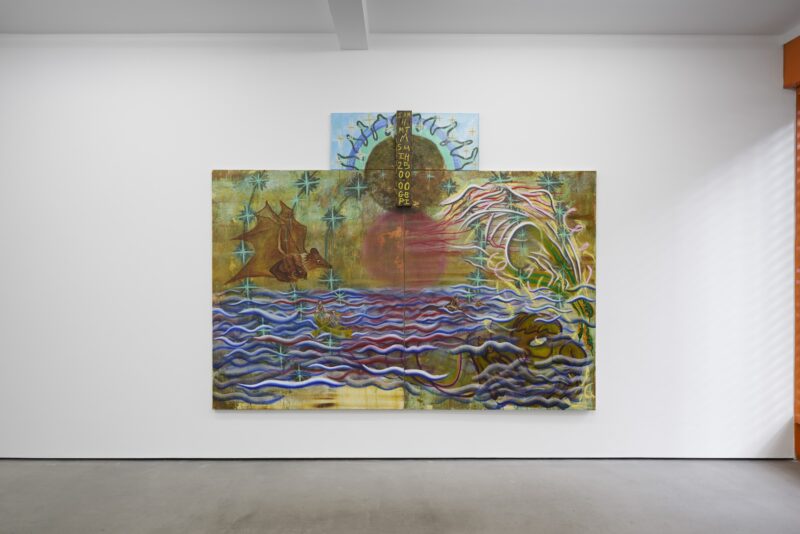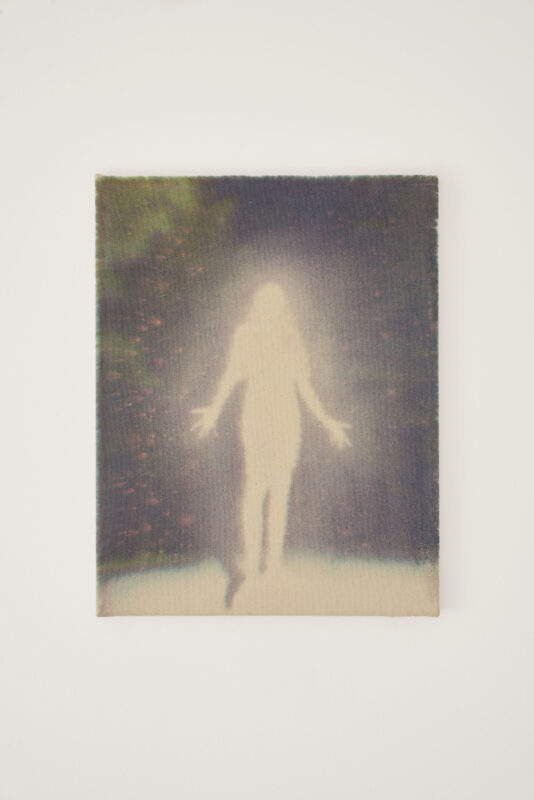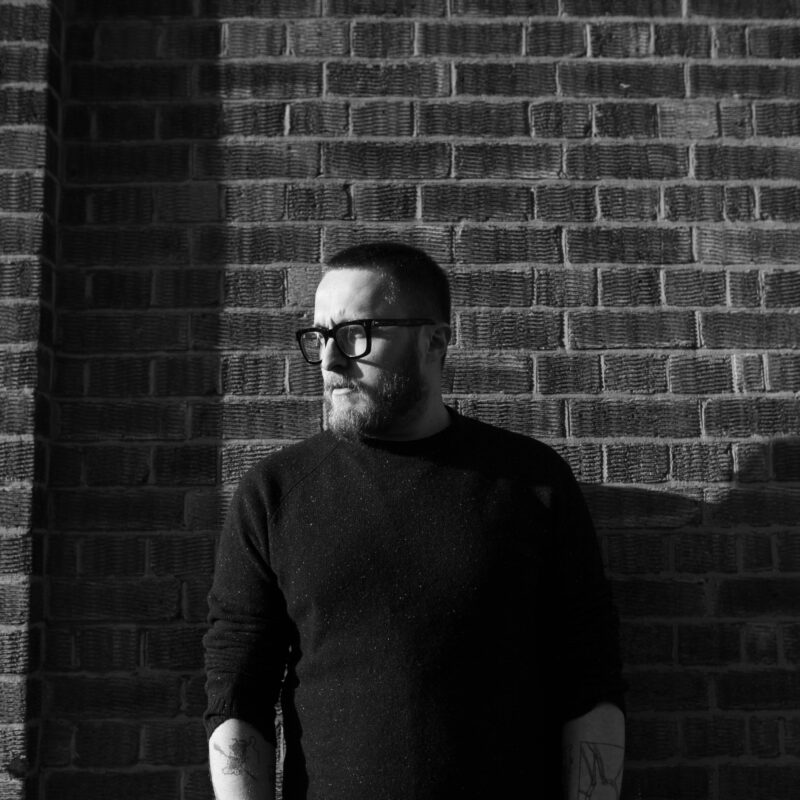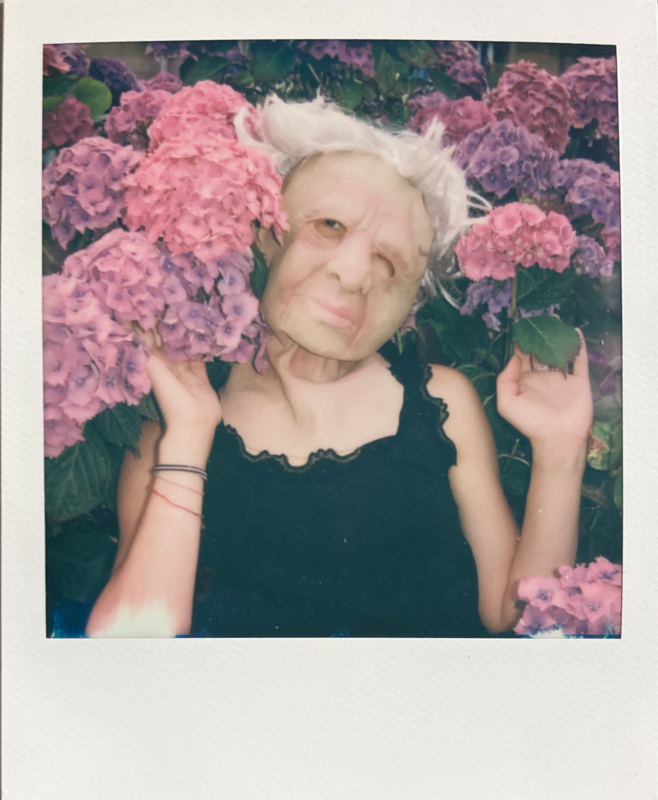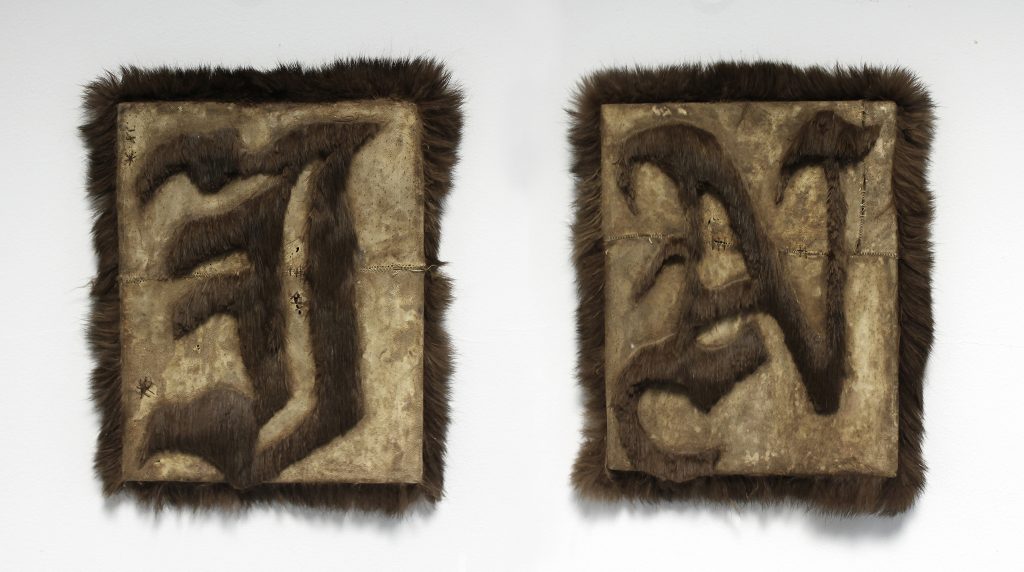
India Nielsen, Interesting Poetry Vol. 1 (I), Interesting Poetry Vol. 1 (II), Installation view, 2019, Shaved fur, 20.32 x 25.4 cm / 8 x 10 in
London based artist India Nielsen recently sat down with art historian, writer and curator Hector Campbell to discuss her use of visual and artistic sampling , her interest in language and use of text, how she employs writing in her painting practice and her current two-person exhibition, RedivideR with Yulia Iosilzon, curated by Campbell at Platform Southwark in London, which runs until February 8th.
Hector Campbell: Having spent seven years in education at three of London’s top art schools – completing your foundation at Central Saint Martins, your BA at The Slade School of Fine Art and your MA at The Royal College of Art – how has the adjustment been to life as a working artist? Do you think art schools prepare students for life after graduating?
India Nielsen: I don’t think art school prepares you for much in terms of “working as an artist”, but what it can do is create an environment in which people are going to be regularly engaging with your work, which I found really helpful. The difference is that in art school you are working very much in a bubble with quite a small, familiar group of people who you’re used to seeing your work. Once you leave it’s great because you’re suddenly free and feel like anything is possible, but then you’re hit with the reality that you’re now solely responsible for your own practice.
I realised quite early on that all of the mechanics of art are invisible anyway, it all falls on, and is driven by, you… so I think that realisation helped me when I left the institutional setting. There’s obviously a lot of precarity in being an artist but the best thing is to just roll with it.
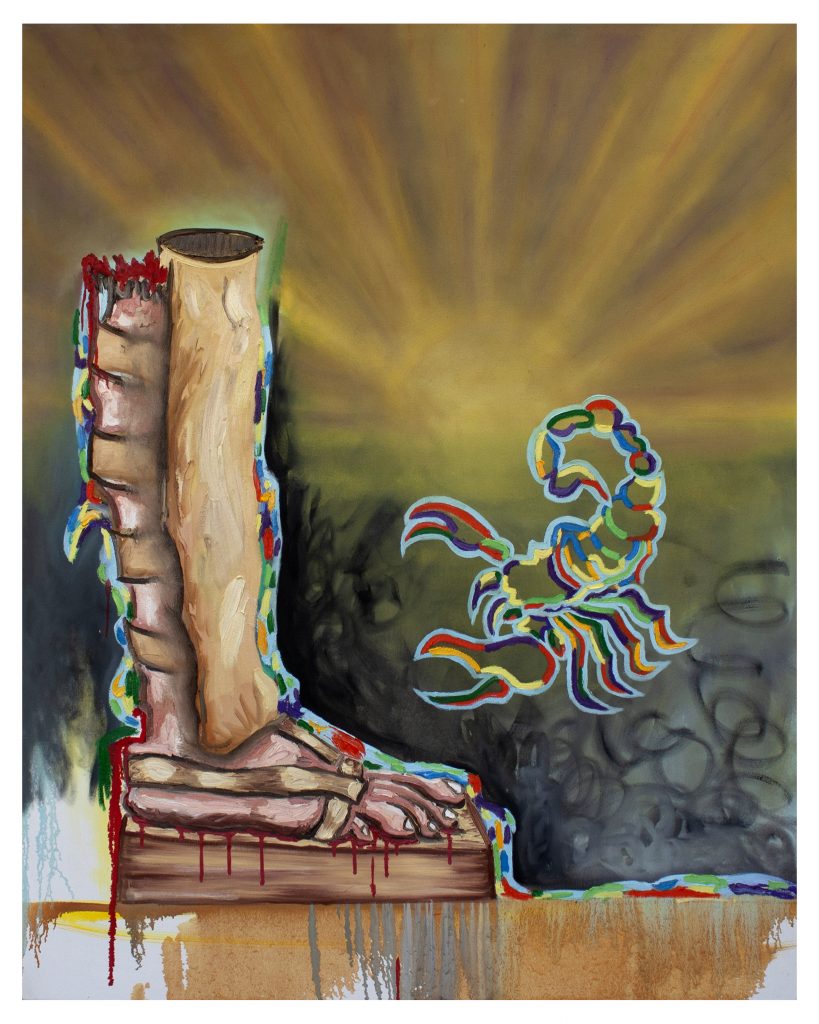
India Nielsen, Paul Thek / Scorpio Rising, 2020, Oil on canvas, 127 x 106 cm / 50 x 42 in
H.C: Your paintings blend and mix many artistic styles, references and conventions together, often incorporating aspects of figuration, abstraction and expressionism into one work, in a process you have likened to that of a music producer sampling from different tracks. What are the wider conceptual ideas that underpin your material practice? And where do you sources your visual references from?
I.N: I mostly source images from the internet or from books, other artworks or comics etc. that remind me of things that have happened in my life. I like to try and recreate a feeling by piecing these references together. In this way, they are always kind of lamenting, even though you might not explicitly see it in the paintings. The feeling I have when I make work is like I’m trying to piece back together something that’s gone.
I’m always compulsively collecting images, keeping them in folders on my laptop and then selecting images that match a particular mood or feeling brought on by a memory. The images themselves act as symbols or stand-ins, the way images in dreams do, just as when you try to get up close to a face but the features keep shifting. I have a lot of vivid dreams with recurring characters and motifs that always leave me with a really bizarre feeling that it is a puzzle I have to decode as these characters are often trying to communicate but are blocked in some way. I do often have the feeling when I paint that I’m searching for something that’s always just slightly out of frame.
I grew up in the early 2000s listening to a lot of producers like Aphex Twin and Kanye West who mastered the technique of remixing and sampling, so when I started making images it just felt natural to approach painting as a sampling of preexisting imagery and references. I pick artists that I believe hold the kind of qualities I want the paintings to have and mix them together. For example, Picabia’s transparent paintings feel really hazy and disorientating, whereas Guston works feel really thick and sensual and Peter Saul’s figures are boneless and synthetic, so what would happen if I tried to make a painting that combined all three. I feel like I am inhabiting, or playing as, these artists. I see each work as a living avatar that I must feed with energy to survive, except here they run on emotion rather than electricity as their fuel.
It’s funny because the idea of sampling is obviously reconfiguring the old to make something new, it’s simultaneously driving itself forward but at the same time pointing to preexisting forms and saying, “this melody or part of this painting from the 1930s is still relevant today, it still evokes emotion.” So it’s pushing forward while also allowing itself to be pulled back by the past as when it comes to basic human emotions, not much really changes over time. As much as my work is a kind of lamentation, I’m also always trying to make something that feels new and surprises me.
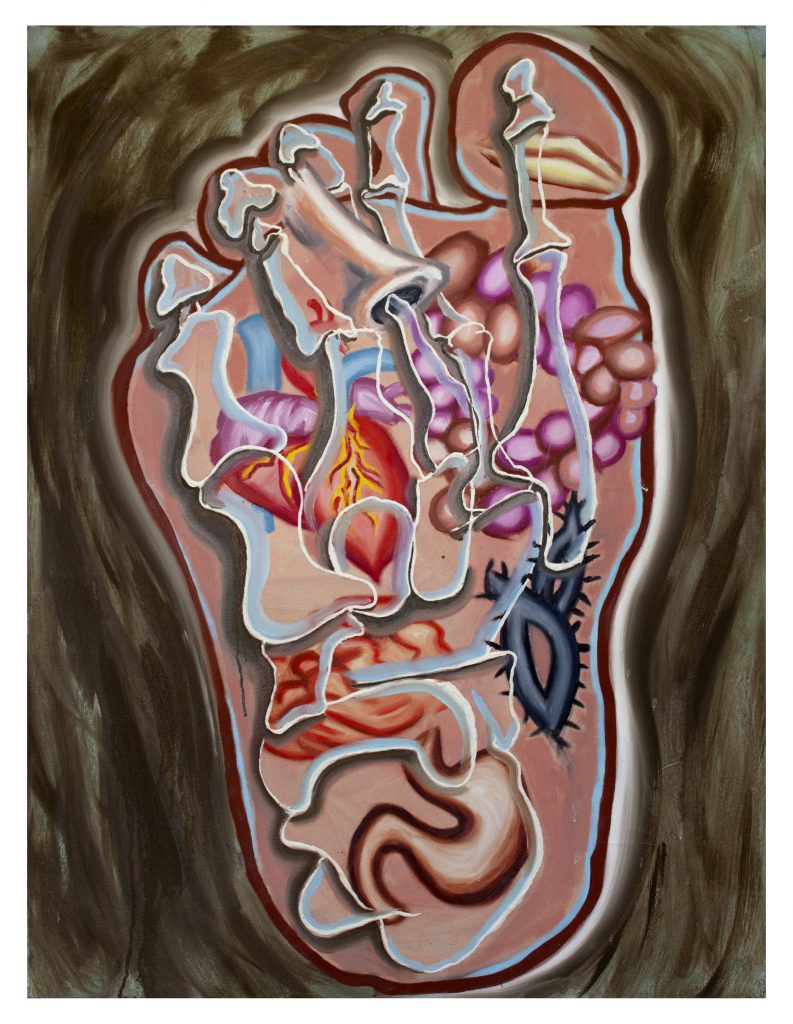
India Nielsen, ooF, 2018, Oil on canvas, 100 x 76 cm / 39.4 x 29.9 in
H.C: Text and symbolism are always present within both your paintings and sculptural work, as you construct your own, unique visual language to communicate with the viewer. What interest you about language as a means of information transmission? And how do you attempt to create a comprehensive alternative?
I.N: I instinctively gravitated towards painting because it’s a really slow medium, a direct contrast to the overwhelming, frenetic way we process information on the internet that puts the viewer in a passive position. Looking at a painting, however, is a very different experience – to engage with a painting the viewer has to be generous enough to meet you halfway, so I want the paintings to be generous too.
I’m not really trying to create an alternative, rather I am trying to create a mood or emotion using the passive, disconnected imagery we find online. If there is a narrative it’s layered, forming a network rather than being linear. I try to keep the painting open to everything, like an emotional spleen filtering through all the imagery around me.
H.C: The titles of your works also address the concept of linguistics and are often semi-legible sentences or phrases, such as ‘Melting m oughts oMe ot Tnthli Egins’, ‘tooF’ or ‘Hetifr oow M ars / Snmimfeg ni tears’. How do you arrive at the titles for your works? And what do these forms of titles add to the work or concept as a whole?
I.N: I like playing with titles as I play with the imagery in the paintings. Some are anagrams or initials, sigils or messages, sometimes they’re even titles of songs I’ve been listening to when I was making the work. Other titles are pretty straightforward and blunt. Like me.
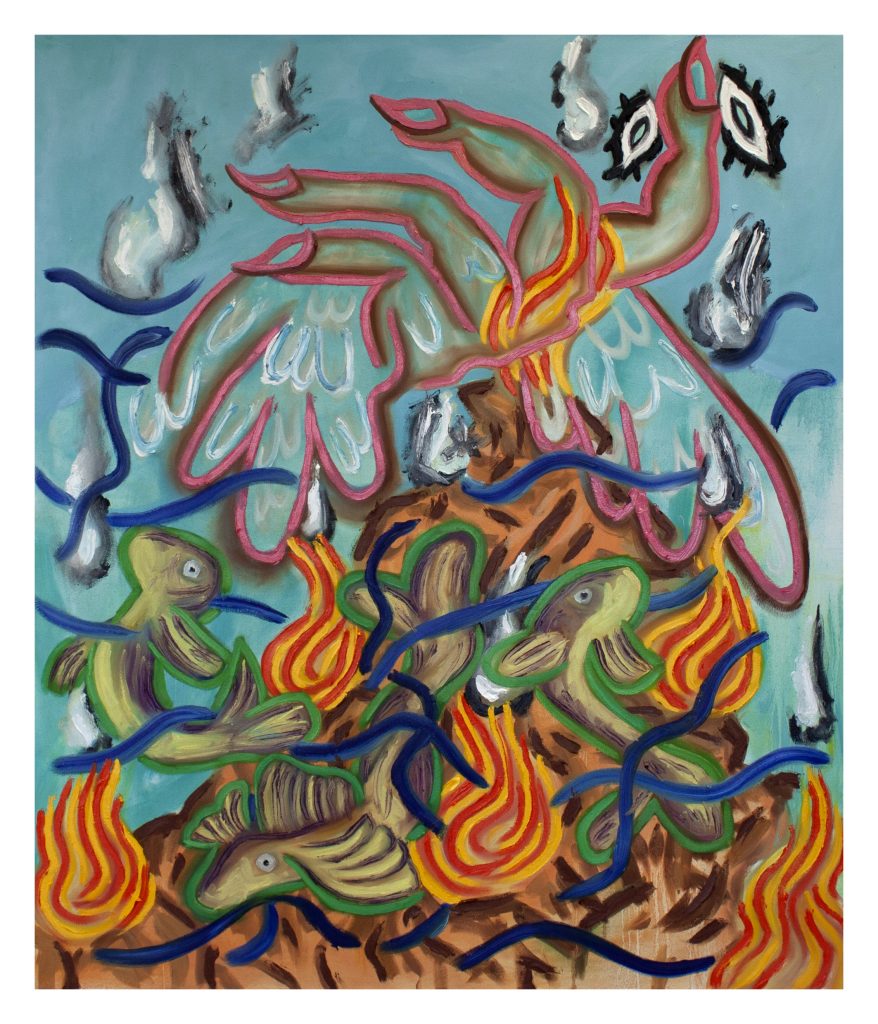
India Nielsen, Hetifr oow M ars / Snmimfeg ni tears, 2020, Oil on canvas, 120 x 160 cm / 39.4 x 59.1 in
H.C: Your sculptural works come in the form of verbal modules made from repurposed materials, that are exhibited either attached to you paintings as fragmented framing devices or independently as individual elements. What are you thought on how their impact changes whether they are accompanying the paintings or detached? And how do you arrive at the words you wish to immortalise in your modules?
I.N: When I started making those works I was thinking about the frame as a device that extends the painting into the space around it, but for me, the standard frame also feels restrictive. I wanted to try and use framing in a dynamic way that could move between works and the surrounding space. These sculptural modules are therefore much more dependent on their immediate physical context than the paintings. They are made to fill the gaps in between things, like textual Tetris pieces to be slotted in and around the architecture of the space and the paintings.
For these modules, some of the words are nicknames or in-jokes that have come out of conversations, others are just short sum-ups of a particular mood or feeling. I sometimes use them as a way of looping works together, positioning them with certain paintings so that the words flow together and form a sentence.
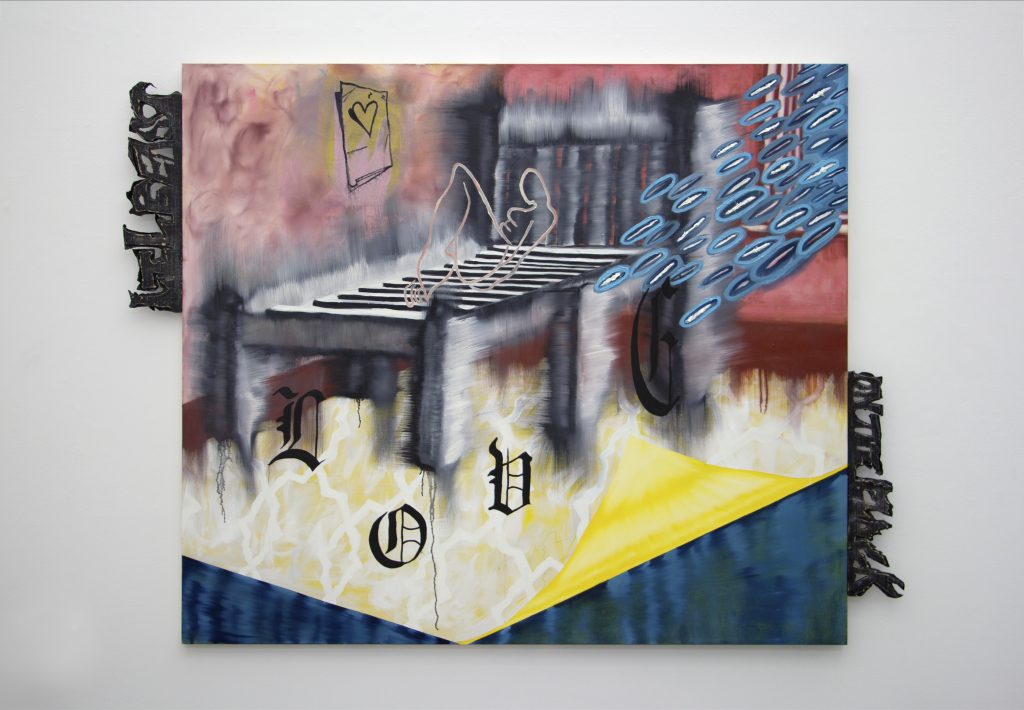
India Nielsen, Love is (Lil Beast on the Block), Installation View, 2019, Oil on canvas with modules, 180 x 210 cm / 82.7 x 70.9 in
H.C: RedivideR also features both wall-based and floor-based works fabricated from reclaimed vintage fur coats, dyed, shaved and sewn into further letters, signs or symbols. What initiated you begin working on this particular body of work, and to start experimenting with fur as an artistic medium?
I.N: The fur pieces grew out of the modular, sculptural pieces. With the modules, I had been using a lot of DIY materials (wood, gaffa-tape, glitter, aluminium foil) as I like using materials that can be found anywhere and don’t conceal what they are. With the fur pieces it’s obvious you’re looking at a piece of shaved fur, there’s nothing illusionistic or particularly technical about it, but at the same time, the way they’ve been shaved into these tight, unnatural calligraphic forms pushes them into this bizarre middle zone that feels talismanic to me. I grew up in an Italian Roman-Catholic family so I think I’ve carried through this compulsion of seeing imagery as magical, transportive objects.
H.C: Alongside your own artistic output, you also write about art and artists for the likes of Mousse Magazine and Herald St gallery, and received the a-n Arts Writing Prize in 2019. How does writing about the artworks of other effect and influence your own art practice, if at all?
I.N: I’ve always written a lot, especially before I start a painting. When I paint I try and turn my brain off completely, so I use the writing as architectural notes to remind myself of the direction I want the work to go in, what elements I want to synthesise etc. With writing for magazines it’s really just a good excuse to research or talk to artists I’ve never met before and learn from them.
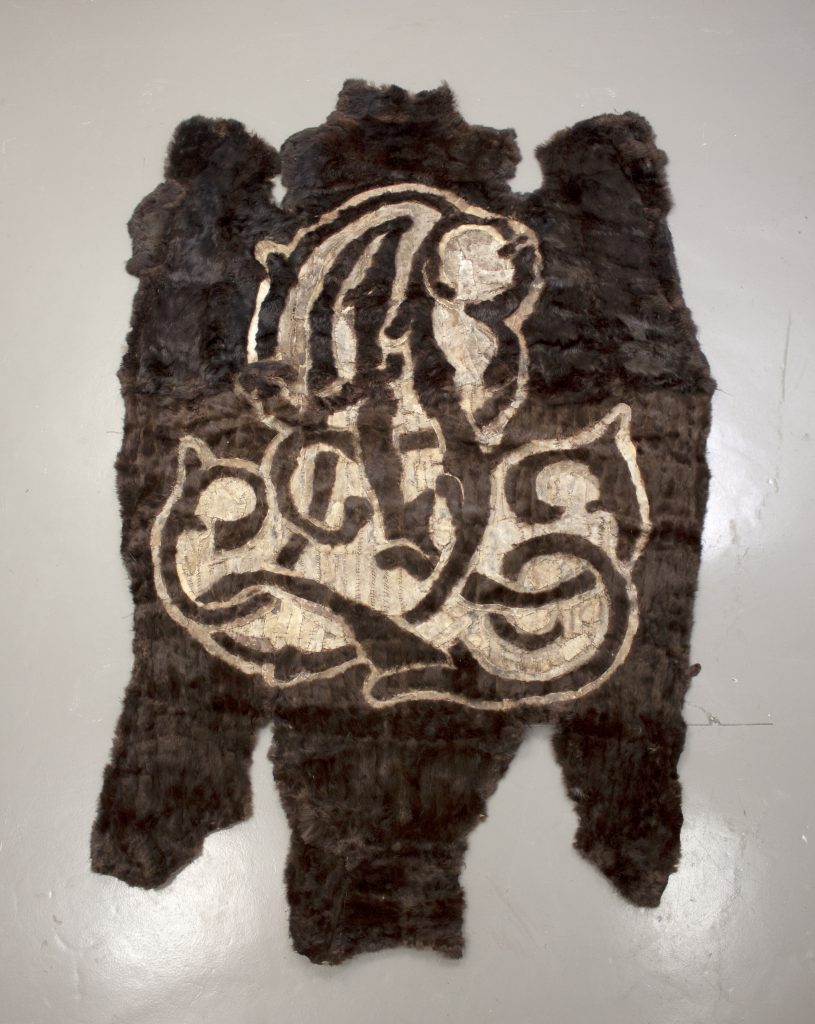
India Nielsen, Interesting Poetry (III), Installation view, 2020, Shaved fur, 190 x 123 cm / 74.8 x 48.4 in
H.C: Finally, could you tell us a little about the works included in RedivideR? How did you approach the exhibition opportunity?
I.N: For RedivideR I wanted to find a way to bring together the three elements I’ve been working on more recently – paintings, modules and furs – to create a convincing semi-narrative environment. I wanted all the elements to feel like they belonged to the same world, that they exist as a network but can also stand alone. I think we pulled it off…
RedivideR, Yulia Iosilzon & India Nielsen, curated by Hector Campbell at Platform Southwark is open until February 8th, by appointment during the week and between 11am-5pm on weekends.
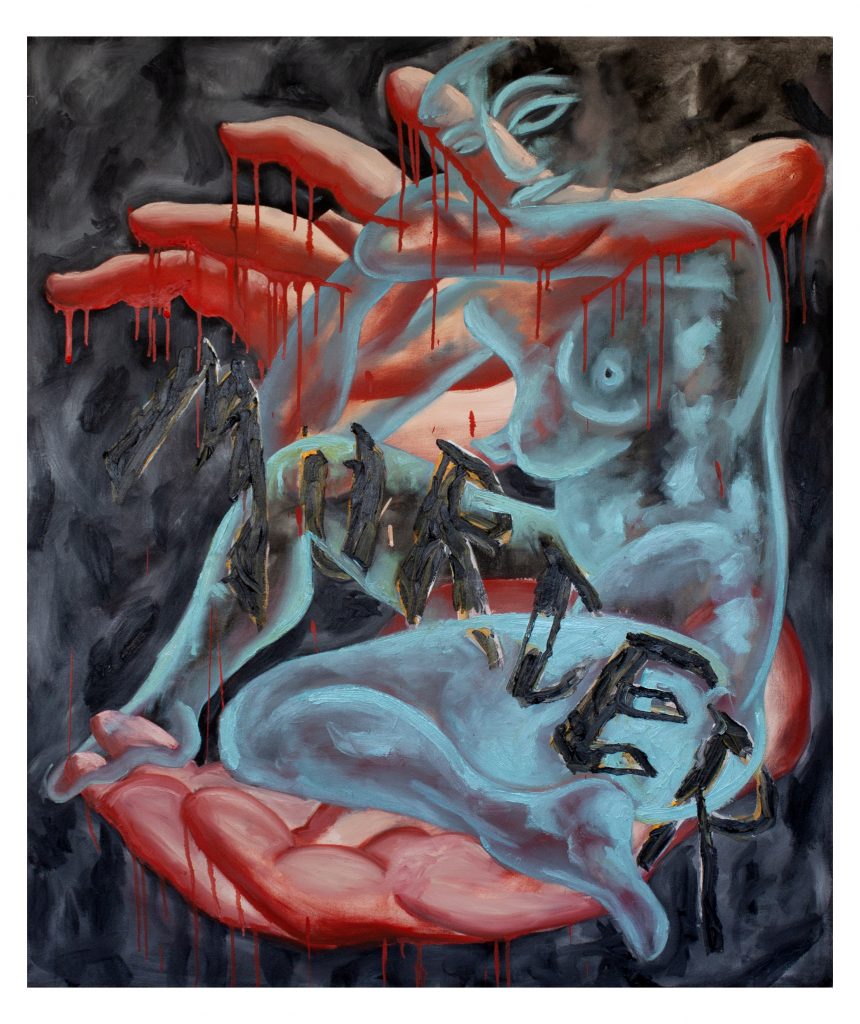
India Nielsen, Melting m oughts oMe ot Tnthli Egins, 2020, Oil on canvas, 140 x 115 cm / 55 x 45 in
